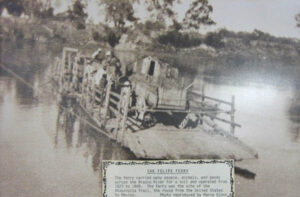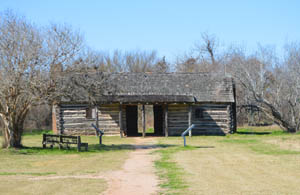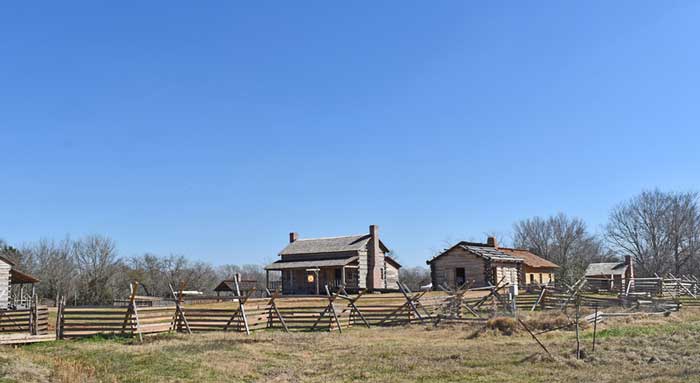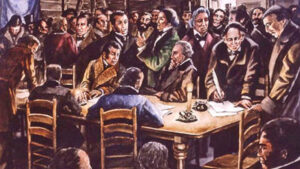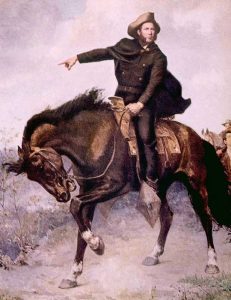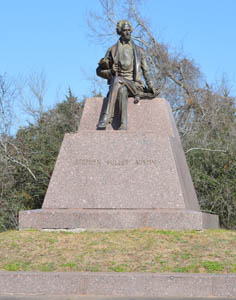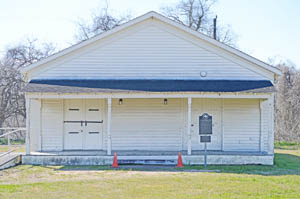San Felipe de Austin, Texas, was chosen by Stephen F. Austin as the unofficial capital of his colony in Mexican Texas in October 1823.
Before Austin’s arrival, John McFarland operated a ferry on the Brazos River.
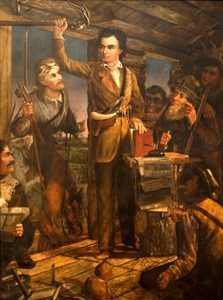
The Settlement of Austin’s Colony by Henry Arthur McArdle
After briefly considering a location on the lower Colorado River, Austin decided to establish his capital at the Brazos River crossing of the Atascosito Road, a military road built by the Spanish in 1757 that connected San Antonio to Louisiana. Situated on an easily defensible bluff overlooking broad, fertile bottomland, the location also provided a central location and sources of fresh water in addition to the Brazos River.
Founded in 1824 as San Felipe de Austin, the town served as the capital of Stephen F. Austin’s first colony and the founding site of the Texas Rangers. The town was named after Stephen Austin and Felipe de la Garza, commanding general of the Eastern Interior Provinces. James Cummins was appointed as the first alcalde or mayor.
The Town of San Felipe de Austin, which included about 22,000 acres of land, was Austin’s first official land grant. The deed, granted on July 1, 1824, dedicated the town’s public spaces, such as the streets, squares, ferry landing, and timberlands, and included specifications for where certain buildings would be constructed.
Stephen F. Austin planned for his town to have a regular street grid with four public plazas, and surveyor Seth Ingram laid out the town and lots according to Austin’s design. Along Constitution Square would be a church, and municipal buildings such as a town hall, courthouse, and jail would be west of the square. A public market would be built along Commerce Square, and military barracks and storehouses would be established alongside Military Square.
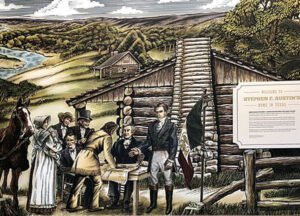
Stephen Austin home in San Felipe, Texas
Austin built his first log cabin residence on Bullinger’s Creek, a half-mile west of the Brazos River, from which he directed the government of his colony for four years. As an empresario or land contractor, to the Mexican government, Austin oversaw the distribution of almost six million acres of land in Texas from his San Felipe land office. His first contract allowed him to bring 300 families from the United States — a group known as the “Old 300.” Four more contracts authorized Austin to settle an additional 1,700 families. These colonial land grants began the most rapid and significant transformation of population and land use in Texas history.
San Felipe soon became the first urban center in the Austin colony, stretching northward from the Gulf of Mexico to the Old San Antonio Road and extending from the Lavaca River in the west to the San Jacinto River in the east.
Keelboats and wagons shipped goods between the town and the coastal ports. Numerous roads were built to link it to the rest of Austin’s colony. Roads radiated out from the town and led to places like Brazoria, the Old Fort on the Brazos, Harrisburg, Victoria, and Matagorda.
The colony’s regular mail service was inaugurated in 1826 when Samuel May Williams was appointed as the San Felipe postmaster. With seven separate postal routes converging here, the town remained the hub of the Texas postal service until the Texas Revolution in 1836.
Several large cotton plantations were established in the bottomlands near the town during the 1820s, and from the outset, San Felipe de Austin became a trading center.
By 1825 Austin had moved to a new house that was substantially improved using lumber from a new sawmill located seven miles upriver from San Felipe. It was later improved again with the installation of brick footings and chimneys.
By 1828, San Felipe had been surveyed, with Calle Commercio laid out as the main commercial street. Austin and his secretary, Samuel May Williams, both resided in log cabins on the square. Jonathan Peyton also ran a tavern on the square. By that time, the community boasted three general stores, two saloons, a hotel, a blacksmith shop, 40-50 log cabins, and a population of about 200.
Though the town was planned on the Mexican town model with a regular grid of avenues and streets dominated by four large plazas, the buildings were initially constructed haphazardly. The settlement soon began to sprawl westward from the Brazos River for more than a half-mile.
The village “consists, at present, of forty or fifty wooden houses on the western bank of the large river known as Rio de los Brazos de Dios, but the houses are not arranged systematically so as to form streets; but on the contrary, lie in an irregular and desultory manner,” and that the “dwellings are scattered about after the manner of new Anglo-American towns. One finds at the most forty to fifty families, for most of the colonists live amid their fields.”
Mexican Boundary Commission, 1928
Stephen F. Austin served as the colony’s civil authority until an Ayuntamiento, or governing body was formed in 1828. After the Ayuntamiento was elected, more town and garden lots were sold at several auctions through 1830, and additional garden plots were platted.
In the meantime, San Felipe de Austin had become the second largest town in colonial Texas, second only to San Antonio. The social, economic, and political center of the Austin colony, its expanding but unstable population swelled by large numbers of immigrants and transients. Stores offered merchandise imported from the United States, and inns and taverns provided lodging and meals for residents and travelers. Blacksmiths, gunsmiths, watchmakers, hatters, tailors, cobblers, tinsmiths, and bakers served the community. Its buildings included a school that also housed the first Sunday School in Texas, a log store building reused as a Catholic church, and an unfinished hotel occupied as the Town Hall. One of the earliest newspapers in Texas, the Texas Gazette, began publication in San Felipe on September 25, 1829. The first book ever published in Texas came from its press that same year.
While other colonies were established in Mexican-owned Texas, San Felipe remained the primary seat of government. Between 1832 and 1835, the “People of Texas” met in convention three times at San Felipe to protest Mexican policies and eventually consider breaking free from Mexico. The evolving Texas government ruled from San Felipe for five months during the seven-month-long Texas Revolution. Working to unite the colonies, the provisional government organized the army, established what would become the Texas Rangers, and initiated a postal system for Texas. Gail Borden’s Telegraph & Texas Register, which became the unofficial journal of the revolution, was first published in San Felipe de Austin on October 10, 1835. The print shop also published some of Texas’ most famous documents that rallied support for the Texas Revolution in 1835-1836.
By 1836, the town’s population was nearly 600, with many more settlers residing nearby.
San Felipe de Austin served as the capital of the provisional government until the Convention of 1836 met on March 1 at Washington-on-the-Brazos. At this meeting, the delegates adopted a formal declaration of independence.
San Felipe served as the political center of the Texas Revolution and in a key military role. San Felipe attorney William Barret Travis commanded the Texian troops at the Alamo in March 1836. After the fall of the Alamo, on March 6, 1836, General Sam Houston’s army retreated through San Felipe de Austin.
Houston then ordered a further retreat toward the east. However, Captain Moseley Baker and the San Felipe militia refused to abandon the town, so Houston ordered them to defend the ferry and burn the town to keep it from falling into the hands of the advancing Mexican army. On March 30, 1836, the small garrison remaining at San Felipe ordered the town evacuated, and the terrified residents hastily gathered what few belongings they could carry before fleeing eastward during the incident known as the Runaway Scrape. The town was then put to the torch.
Unable to cross the Brazos River at San Felipe, Santa Anna and his army turned southward, ultimately crossing downstream at Fort Bend. The two armies of Houston and Santa Anna would meet two weeks later at San Jacinto, and Texas independence was won on the battlefield.
By May 1836, as news of the Texans’ victory at the Battle of San Jacinto spread, some residents returned, but many did not. A “new” community was established near the original townsite, but the republic’s government was unable to resume operation in San Felipe due to the lack of necessary buildings. San Felipe was incorporated in 1837, became the county seat of the newly established Austin County, and a courthouse was built.
By the mid-1840s, the only other buildings in the settlement were six or seven log houses and a saloon.
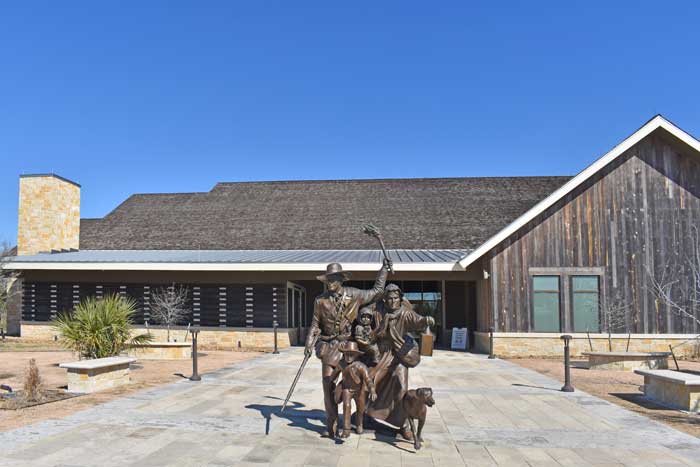
10,000 square-foot state-of-the-art museum at the San Felipe de Austin Historic Site by Kathy Alexander.
In 1846, a traveler reported that San Felipe contained “five to six miserable, dilapidated log and frame buildings… no activities or signs of life visible,”
That year, a county election made the new community of Bellville the county seat, and administrative functions were moved from San Felipe in January 1848.
The community continued to serve as a crossroads for some time due to the existing road network, postal routes, ferry landing, and steamboat stop. However, much of the traffic and mail was routed through the new county seat, and river traffic declined due to the difficult conditions of the Brazos River.
By 1850 San Felipe had a school and two stores, one of which was a general store run by John Crutcher. It was purchased in 1867 by J.J. Josey; it was in continuous operation as a store until 1942. This building has been preserved as a museum at the San Felipe State Historic Site.
In the late 1870s, the town sought to establish a Gulf, Colorado & Santa Fe rail line and depot but failed, and a depot was ultimately built four miles out of town. In 1881, however, San Felipe successfully attracted the Texas Western Railroad Company with the assurance that 50 acres would be donated for a depot site and an additional 2,000 acres from the southeast side of town.
The final agreement stipulated that the depot would be located south and southeast of the original town grid. A “New Town” addition to San Felipe was then platted, lots were sold in 1885 and 1886, and businesses and residents migrated out of the original townsite. “Old Town” was mainly left vacant. The Texas Western Railroad closed ten years later, and San Felipe was bypassed by the new Missouri, Kansas, and Texas Railway.
By 1910 the town had a population of only 206.
In 1928, residents dedicated the original townsite as a commemorative site and have annually held a celebration honoring Stephen F. Austin and early San Felipe ever since. In 1940, the town of San Felipe donated most of the original townsite property to the state, which is now the San Felipe de Austin State Historic Site.
Today, the San Felipe de Austin State Historic Site, listed on the National Register of Historic Places, contains a 10,000 square-foot state-of-the-art museum that shares the stories of early settlers where visitors can walk in their footsteps and features interactive displays and historical artifacts.
Today San Felipe has a population of about 825 people. The oldest post office in Texas is located here.
© Kathy Alexander/Legends of America, January 2022.
Also See:
Sources:
Colonial Capital of Texas
Handbook of Texas Online
National Register of Historic Places
Wikipedia


